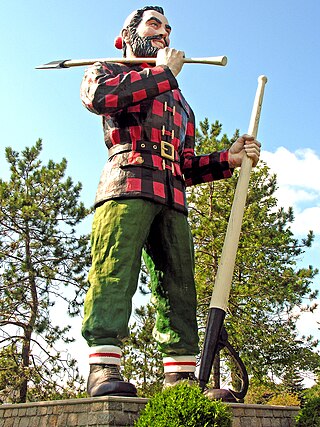
Paul Bunyan is a giant lumberjack and folk hero in American and Canadian folklore. His tall tales revolve around his superhuman labors, and he is customarily accompanied by Babe the Blue Ox, his pet and working animal. The character originated in the oral tradition of North American loggers, and was later popularized by freelance writer William B. Laughead (1882–1958) in a 1916 promotional pamphlet for the Red River Lumber Company. He has been the subject of various literary compositions, musical pieces, commercial works, and theatrical productions. His likeness is displayed in a number of oversized statues across North America.

Lumberjack is a mostly North American term for workers in the logging industry who perform the initial harvesting and transport of trees. The term usually refers to loggers in the era before 1945 in the United States, when trees were felled using hand tools and dragged by oxen to rivers.

Pecos Bill is a fictional cowboy and folk hero in stories set during American westward expansion into the Southwest of Texas, New Mexico, Southern California, and Arizona. These narratives were invented as short stories in a book by Tex O'Reilly in the early 20th century and are an example of American folklore. Pecos Bill was a late addition to the "big man" idea of characters, such as Paul Bunyan or John Henry.

Bemidji is a city and the county seat of Beltrami County, in northern Minnesota, United States. The population was 14,574 at the 2020 census. According to 2022 census estimates, the city is estimated to have a population of 15,946, making it the largest commercial center between Grand Forks, North Dakota and Duluth.

Fosston is a city in Polk County, Minnesota, United States. It is part of the Greater Grand Forks region. The population was 1,434 at the time of the 2020 census.
A tall tale is a story with unbelievable elements, related as if it were true and factual. Some tall tales are exaggerations of actual events, for example fish stories such as, "That fish was so big, why I tell ya', it nearly sank the boat when I pulled it in!" Other tall tales are completely fictional tales set in a familiar setting, such as the European countryside, the American frontier, the Canadian Northwest, the Australian outback, or the beginning of the Industrial Revolution.

Hyperdontia is the condition of having supernumerary teeth, or teeth that appear in addition to the regular number of teeth. They can appear in any area of the dental arch and can affect any dental organ. The opposite of hyperdontia is hypodontia, where there is a congenital lack of teeth, which is a condition seen more commonly than hyperdontia. The scientific definition of hyperdontia is "any tooth or odontogenic structure that is formed from tooth germ in excess of usual number for any given region of the dental arch." The additional teeth, which may be few or many, can occur on any place in the dental arch. Their arrangement may be symmetrical or non-symmetrical.

Nanabozho, also known as Nanabush, is a spirit in Anishinaabe aadizookaan, particularly among the Ojibwe. Nanabozho figures prominently in their storytelling, including the story of the world's creation. Nanabozho is the Ojibwe trickster figure and culture hero.

Paul Bunyan, Op 17, is an operetta in two acts and a prologue composed by Benjamin Britten to a libretto by W. H. Auden, designed for performance by semi-professional groups. It premiered at Columbia University on 5 May 1941, to largely negative reviews, and was withdrawn by the composer. Britten revised it somewhat in 1976 and it has subsequently had numerous performances and two commercial recordings. The story is based on the folkloric American lumberjack, Paul Bunyan, with the music incorporating a variety of American styles, including folk songs, blues and hymns. The work is strongly sectional in nature, highly reminiscent of the 'Broadway musical' style of the period.

Disney's American Legends is a 2001 American animated anthology film narrated by James Earl Jones. It is a compilation of four previously released animated musical shorts from Walt Disney Animation Studios based on American tall tales. The film features The Brave Engineer (1950), Paul Bunyan (1958), John Henry (2000), and The Legend of Johnny Appleseed which is a segment from the 1948 film Melody Time.
Febold Feboldson is an American folk hero who was a Swedish American plainsman and cloudbuster from Nebraska. His exploits were originally published in 1923 in the Gothenburg Independent newspaper and the character is now largely considered a part of fakelore as opposed to a genuine folk hero.
David B. Rogers is an American NASCAR crew chief who works as the performance director for 23XI Racing. He previously worked as a crew chief for Joe Gibbs Racing in both the NASCAR Cup and Xfinity Series as well as the technical director for JGR's Xfinity operations. He has over a decade of experience as a crew chief, all with JGR. Over the course of his career, he has worked in the NASCAR Cup Series and Xfinity Series with drivers Jason Leffler, Denny Hamlin, Aric Almirola, Tony Stewart, Travis Kittleson, J. J. Yeley, Kyle Busch, Joey Logano, Brad Coleman, Matt DiBenedetto, Michael McDowell, Carl Edwards, Daniel Suárez, Matt Tifft, Kyle Benjamin, Riley Herbst, and Daniel Hemric. Hemric and Rogers won the 2021 NASCAR Xfinity Series championship.

Invented traditions are cultural practices that are presented or perceived as traditional, arising from the people starting in the distant past, but which in fact are relatively recent and often even consciously invented by identifiable historical actors. The concept was highlighted in the 1983 book The Invention of Tradition, edited by Eric Hobsbawm and Terence Ranger. Hobsbawm's introduction argues that many "traditions" which "appear or claim to be old are often quite recent in origin and sometimes invented." This "invention" is distinguished from "starting" or "initiating" a tradition that does not then claim to be old. The phenomenon is particularly clear in the modern development of the nation and of nationalism, creating a national identity promoting national unity, and legitimising certain institutions or cultural practices.

Paul Bunyan is a 1958 American animated musical short film produced by Walt Disney Productions. The short was based on the North American folk hero and lumberjack Paul Bunyan and was inspired after meeting with Les Kangas of Paul Bunyan Productions, who gave Disney the idea for the film. The film was directed by Les Clark, a member of Disney's Nine Old Men of core animators. Thurl Ravenscroft starred as the voice of Paul Bunyan. Supporting animators on the project included Lee Hartman.
Quebec has a rich history of folklore.

Canadian folklore is the traditional material that Canadians pass down from generation to generation, either as oral literature or "by custom or practice". It includes songs, legends, jokes, rhymes, proverbs, weather lore, superstitions, and practices such as traditional food-making and craft-making. The largest bodies of folklore in Canada belong to the aboriginal and French-Canadian cultures. English-Canadian folklore and the folklore of recent immigrant groups have added to the country's folk.
Since the folkloric hero Paul Bunyan's first major appearance in print, the character has been utilized to promote a variety of products, locations, and services. The giant lumberjack's mass appeal has led him to become a recurring figure in entertainment and marketing, appearing in various incarnations throughout popular culture.
Wenona Beach Amusement Park was an amusement park in Bay County, Michigan located along the Saginaw Bay near Bangor Township and the mouth of the Saginaw River. The park opened in 1887 and closed in 1964.
Harold William Felton was an American writer and folklorist, an author of many children's books and books of American tall tales, among others.

Albert Lewis Johnson., better known as Jigger Johnson, was a legendary logging foreman, trapper, and fire warden for the U.S. Forest Service who was known throughout the American East for his many off-the-job exploits, such as catching bobcats alive barehanded, and drunken brawls.












